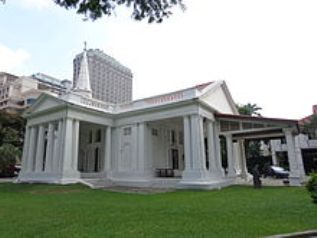Armenian Church
60 Hill St, Singapore 179366
Phone :+65 6334 0141
Armenian Church is a national Monument of Singapore.
The Armenian Church of Saint Gregory the Illuminator , often known as Armenian Church, is the oldest Christian church in Singapore located at Hill Street in the Museum Planning Area, within the Central Area. Originally a parish of the Armenian Apostolic Church, an Oriental Orthodox denomination, the last Armenian parish priest left in the late 1930s, and with the dwindling Armenian population in Singapore. Fr. Zaven Yazichyan became the spiritual pastor of Singapore on 29 March 2016. Armenian and Oriental Orthodox services are regularly held at the church.
The Armenian Church was gazetted as a national monument on 6 July 1973.
The original, elegant and symmetrical design included neither tower nor spire. It featured an octagonal cone supporting a small bell turret with Ionic columns.
The existing Armenian Church, built in the British neoclassical style, is centrally-designed in the manner of the mother church of Echmiadzin in northern Armenia. The church interior is circular, imposed within a square-cross plan, with projecting square porticos using Roman Doric orders. The chancel-cum-altar is semi-circular. The Palladian-style design may have been inspired by the circular plan for St Andrews’s Church in Chennai, which is in turn derived from one of James Gibbs’ designs for St Martin-in-the-Fields in London that he published in his Book of Architecture. The original symmetrical design included neither tower nor spire, instead it featured an octagonal cone supporting a small bell turret with Ionic columns.
Nevertheless, with all the eclectic references, Coleman produced a design which is adapted to suit Singapore’s tropical climate. For instance, the wide verandahs give essential shade and protect the timber-louvred windows on the ground floor from heavy downpours. The windows, in turn, diffuse the sunlight and induce cross ventilation. The pews, which would normally be entirely in wood, are backed with woven rattan, a much lighter and cooler material.
The spire, topped with a ball and cross, sits on the octagonal tower, and is the second to replace the original bell turret by Coleman. It was replaced by a square tower, using Doric pilasters, in 1846, followed by the present spire in 1853. An English architect called Maddock had the pitched roof replaced by the present one and, to support the existing tower and spire, added the east portico around the original chancel. Probably at the same time the main entrance on the west portico was widened.
On the north, south and west fronts of the church are Tuscan Doric porticos capped with triangular pediments. The east front bears an elegant bowed apse with a pediment into which the date “1835” is carved to commemorate the year the church’s foundation was laid. The bowed apse is boxed in by the portico on which the spire was built. The north, south and west porticos were designed such that horse carriages could pull into the porches, right up to the doors of the church. The porches were designed to be on level with the base of the carriages so that ladies could step into the church without soiling their dresses on the ground below.
Although the interior is curcular, said to resemble the famous round Holy Sepulchre in Cambridge, England, it is actually based on a square cross, symbolic of the Cross of Christ. Facing the main entrance is the grand altar, prominently raised above the height of the pews.
On the church grounds are the parsonage and the Memorial Garden to Armenians. The parsonage, a two-storey bungalow, was built in 1905 by Nanajan Sarkies in memory of her late husband, John Shanazar Sarkies. Amongst the Armenians in Singapore, the Sarkies family was probably the most notable, in particular brothers Archak, Aviet and Tigran of Raffles Hotel fame. A number of tombstones of prominent Armenians, such as Agnes Joaquim who bred Singapore’s national flower and Catchik Moses who founded the Straits Times newspaper also lie here.
Source : Wikipedia
Virtual Tours
Exterior
Interior
Source : armeniansinasia.org
https://www.youtube.com/watch?v=Ol56-S_bvwE
https://www.youtube.com/watch?v=OTpa6XsHAks
https://www.youtube.com/watch?v=7nBnx_QB8jI
Reviews
Opening hours : 09.00AM to 06.00PM
Getting there : MRt : City Hall



Rate this article